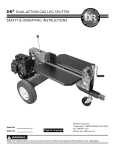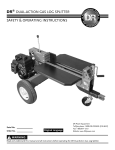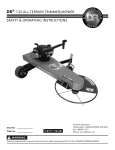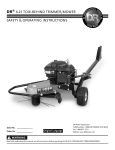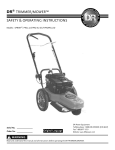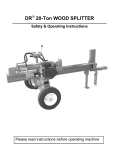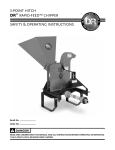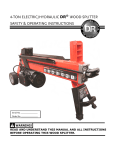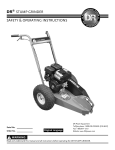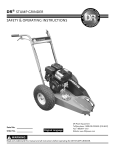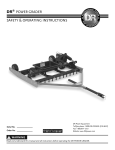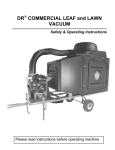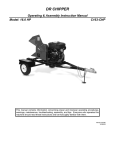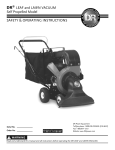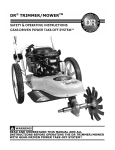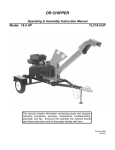Download DR DUAL-ACTION ELECTRIC Operating instructions
Transcript
® ` DR DUAL-ACTION ELECTRIC LOG SPLITTER SAFETY & OPERATING INSTRUCTIONS Serial No. Order No. Original Language DR Power Equipment Toll-free phone: 1-800-DR-OWNER (376-9637) Fax: 1-802-877-1213 Website: www.DRpower.com Read and understand this manual and all instructions before operating the DR Dual-Action Electric Log Splitter. Table of Contents Chapter 1: General Safety Rules............................................................................................................................................................ 3 Chapter 2: Setting Up The DR DUAL-ACTION ELECTRIC LOG SPLITTER ......................................................................................... 7 Chapter 3: Operating Your DR DUAL-ACTION ELECTRIC LOG SPLITTER ........................................................................................ 14 Chapter 4: Maintaining The DR DUAL-ACTION ELECTRIC LOG SPLITTER ...................................................................................... 18 Chapter 5: Troubleshooting .................................................................................................................................................................. 21 Chapter 6: DR DUAL-ACTION ELECTRIC LOG SPLITTER Road Towable Kit ..................................................................................... 24 Chapter 7: Parts Lists, Schematic Diagrams And Warranty ................................................................................................................ 28 Conventions used in this manual This indicates a hazardous situation, which, if not avoided, could result in death or serious injury. This indicates a hazardous situation, which, if not avoided, could result in minor or moderate injury. This information is important in the proper use of your machine. Failure to follow this instruction could result in damage to your machine or property. Serial Number and Order Number A Serial Number is used to identify your machine and is located on the Serial Number Label on your machine. An Order Number is used to check and maintain your order history and is located on your packing slip. For your convenience and ready reference, enter the Serial Number and Order Number in the space provided on the front cover of this manual. Additional Information and Potential Changes DR Power Equipment reserves the right to discontinue, change, and improve its products at any time without notice or obligation to the purchaser. The descriptions and specifications contained in this manual were in effect at printing. Equipment described within this manual may be optional. Some illustrations may not be applicable to your machine. 2 DR® DUAL-ACTION ELECTRIC LOG SPLITTER Chapter 1: General Safety Rules Read this safety & operating Instructions manual before you use the DR DUAL-ACTION ELECTRIC LOG SPLITTER. Become familiar with the operation and service recommendations to ensure the best performance from your machine. If you have any questions or need assistance, please contact us at www.DRpower.com or call toll-free 1-800-DR-OWNER (376-9637) and one of our Technical Support Representatives will be happy to help you. Labels Your DR DUAL-ACTION ELECTRIC LOG SPLITTER carries prominent labels as reminders for its proper and safe use. Shown below are copies of all the Safety and Information labels that appear on the equipment. Take a moment to study them and make a note of their location on your Log Splitter as you set up and before you operate the unit. Replace damaged or missing safety and information labels immediately. # 27609 # 29395 #29394 CONTACT US AT www.DRpower.com 3 Protect Yourself and Those Around You This is a high-powered machine, with moving parts operating with high energy. You must operate the machine safely. Unsafe operation can create a number of hazards for you, as well as anyone else in the nearby area. Always take the following precautions when using this machine: Keep in mind that the operator or user is responsible for accidents or hazards occurring to other people, their property, and themselves. Always wear protective goggles or safety glasses with side shields while using the Log Splitter to protect your eyes from possible thrown debris. Avoid wearing loose clothing or jewelry, which can catch on moving parts. We recommend wearing gloves while using the Log Splitter. Be sure your gloves fit properly and do not have loose cuffs or drawstrings. Wear shoes with non-slip treads when using your Log Splitter. If you have safety shoes, we recommend wearing them. Do not use the machine while barefoot or wearing open sandals. Wear long pants while operating the Log Splitter. Use ear protectors or ear plugs rated for at least 20 dBA to protect your hearing. Keep bystanders at least 50 feet away from your work area at all times. Stop the motor when another person or pet approaches. Hydraulic Safety High fluid pressures are developed in hydraulic machines. Pressurized hydraulic fluid escaping through a pin hole opening can puncture skin and cause severe blood poisoning. Therefore, the following Instructions should be heeded at all times. Do not operate the unit with frayed, kinked, cracked or damaged hoses, fittings, or tubing. Stop the motor, wait 5 minutes and relieve hydraulic system pressure before changing or adjusting fittings, hoses, tubing, or other system components. The relief valve settings are set at the factory for best Splitter performance and safety. Make sure other factors such as using an extension cord that is not rated for this application is not the problem before adjusting valve settings. Do not check for leaks with your hand. Leaks can be located by passing cardboard or wood over the suspected area: Look for discoloration. If injured by escaping fluid, see a doctor at once. Serious infection or reaction can develop if proper medical treatment is not administered immediately. Always wear safety glasses to protect your eyes from hydraulic fluid. Safety for Children and Pets Tragic accidents can occur if the operator is not alert to the presence of children and pets. Children are often attracted to the machine and the splitting activity. Never assume that children will remain where you last saw them. Always follow these precautions: Keep children and pets at least 50 feet from the working area and ensure they are under the watchful care of a responsible adult. Be alert and turn the machine off if children or pets enter the work area. Never allow children to operate the Log Splitter. 4 DR® DUAL-ACTION ELECTRIC LOG SPLITTER Safety with Electric - Powered Machines Never overlook the hazards of electricity. Always follow these precautions: Never open the switch box or motor cover. Never attempt any electrical repairs yourself. If in doubt, consult a qualified electrician, visit our website at www.DRpower.com or contact DR Power Equipment for toll-free support at: 1-800-dr-owner (376-9637) for help or information. Never use an extension cord that is not rated for outdoor use. Never operate the Log Splitter if there is an electrical hazard present. Never operate the Log Splitter in wet conditions and always store under cover. Never operate the Log Splitter with a damaged electrical cord or damaged extension cord. Never pull on the electrical cord to move the machine. Always grasp the electrical cord plug when unplugging the cord from the outlet; never pull the plug out by the cord. Make sure your fingers do not touch the metal prongs when plugging or unplugging. Never operate the Log Splitter unless the electrical cord is plugged into a properly grounded GFCI protected electrical outlet, which supplies 110-120v power, and is protected by a 20-amp circuit breaker. Never tamper with safety devices. Check their proper operation regularly. If you are using an extension cord, keep the connection between the electrical cord and the extension cord well away from any water. Never use an extension cord longer than 25 feet and smaller than 12 awg in diameter, or longer than 50 feet and smaller than 10 awg in diameter; the cord will produce a voltage drop that will prevent the motor from supplying full power and may cause damage to the motor. Use of a smaller diameter (larger awg number) extension cord could result in melting of the insulation or even create a fire. Always keep the electrical cord and/or extension cord away from excessive heat, oil, and sharp objects. Towing (optional Road Tow Kit) ALWAYS check before towing to make certain your splitter is correctly and securely attached to the towing vehicle. Be sure that the ball hitch you are using is the proper size for the hitch coupler on the splitter. Be sure the safety chains are properly hooked to the vehicle leaving enough slack for turning. ALWAYS raise the jack to the highest setting before transporting the splitter. ALWAYS use accessory lights and devices when transporting on a road or highway to warn operators of other vehicles. Check your local government regulations for DOT information. ALWAYS allow for added length of the splitter when turning, parking, crossing intersections, and in all driving situations. ALWAYS be careful when backing up. You could jackknife your splitter if care is not taken. ALWAYS travel slowly over rough terrain, on hillsides, and around curves to prevent tipping. NEVER exceed 30 mph. when towing your splitter. Obey all state and local regulations when towing on state and local roads and highways. Adjust your speed for terrain and conditions, as needed. Be extra cautious when towing over rough terrain, especially over a railroad crossing. NEVER allow anyone to sit or ride on your splitter. NEVER carry any cargo on your splitter. NEVER tow the splitter near the edge of a ditch. General Safety Operating this Log Splitter safely is necessary to prevent or minimize the risk of death or serious injury. Unsafe operation can create a number of hazards for you. Always take the following precautions when operating this Log Splitter: Your Log Splitter is a powerful tool, not a plaything. Exercise extreme caution at all times. The machine is designed to Split Logs. Do not use it for any other purpose. CONTACT US AT www.DRpower.com 5 Allow only one person to operate the Log Splitter at any time. If the machine should start making an unusual noise or vibration, turn the machine off and unplug the electrical cord and allow the machine to cool, then inspect for damage. Vibration is generally a warning of trouble. Check for damaged parts and clean, repair and/or replace as necessary. Never tamper with safety devices. Check their proper operation regularly. Never allow people who are unfamiliar with these instructions to use the Log Splitter. Allow only responsible individuals who are familiar with these rules of safe operation to use your machine. Never overload or attempt to split logs beyond the manufacturer’s recommendation. Personal injury or damage to the machine could result. While using the Log Splitter, don't hurry or take things for granted. When in doubt about the equipment or your surroundings stop the machine and take the time to look things over. Never operate the machine when under the influence of alcohol, drugs, or medication. Use the machine only in daylight. Keep all nuts and bolts tight and keep the equipment in good operating condition. Always cut the ends of the log you are splitting as squarely as possible. Never split more than one log at a time unless you fully extended the ram and you need a second log to complete the split of the first log. Never put anything between the log trays and the side of a log; logs spread as they are forced against the wedge. Never operate the wedge in a stalled position for more than five (5) seconds. The hydraulic fluid may overheat and damage the machine. If the wood being split is excessively hard, stop the machine, rotate the log 180 and try again. If you still cannot split the log, reject the log as it exceeds the capacity of the machine. Never leave the Log Splitter unattended while plugged in. If you leave the area, unplug from the power source. Clean up as you work; accumulated split wood and wood chips can create a hazardous work environment. Keep your hands and feet away from the splitting area while the wedge is in motion. Use only your hands to operate the Log Splitter controls. Do not place your hands at pinch points where they can catch between a log and the wedge, log trays or the ram. Do not put any part of yourself, your clothing, or your personal protective equipment into a crack in a log that you are splitting; it might close suddenly with great force. Never split anything other than logs free of nails, wires, and branches. Maximum log length is 20" with a maximum diameter of 24" for the DR DUAL-ACTION ELECTRIC LOG SPLITTER. Never operate the Log Splitter in an area of natural gas or flammable liquids. Always operate the Log Splitter from the operator zone (Chapter 3). Never stand on, straddle, or climb over the Log Splitter at any time. Do not handle logs by their ends when you position them on the Log Splitter. Handle from the sides of the log. Always unplug the Log Splitter from the power source before adjusting or servicing the machine. If you have to stop to remove any debris from the machine, always retract the ram and unplug the machine. Do not move or reposition the Log Splitter with its motor running. Check the Log Splitter before turning it on. Never use the machine without ensuring that all guards and shields are in place. Replace damaged, missing or failed parts before using the Splitter. Never, under any conditions, remove, bend, cut, fit, weld, or otherwise alter standard parts on the Log Splitter. This includes all shields and guards. Modifications to your machine could cause personal injuries and property damage and will void your warranty. Know how to stop the Log Splitter quickly; see “Stopping the Log Splitter” in Chapter 3. Never operate your unit on a slippery, wet, muddy, or icy surface. Exercise caution to avoid slipping or falling. A Note to All Users No list of warnings and cautions can be all-inclusive. If situations occur that are not covered by this manual, the operator must apply common sense and operate this DR DUAL-ACTION ELECTRIC LOG SPLITTER in a safe manner. Contact us at www.DRpower.com or call 1-800-DR-OWNER (376-9637) for assistance. 6 DR® DUAL-ACTION ELECTRIC LOG SPLITTER Chapter 2: Setting Up The DR DUAL-ACTION ELECTRIC LOG SPLITTER It may be helpful to familiarize yourself with the controls and features of your DR DUAL-ACTION ELECTRIC LOG SPLITTER as shown in Figure 1 before beginning these procedures. If you have any questions at all, please feel free to contact us at www.DRpower.com. DR DUAL-ACTION ELECTRIC LOG SPLITTER Controls and Features Splitting Wedge Operator Lever Log Tray Pneumatic Tires Dipstick/Hydraulic Fluid Fill Jack Hydraulic Fluid Pump Assembly Electric Motor Hydraulic Fluid Tank Reset Button Electric Motor On-Off Switch Electrical Cord Figure 1 CONTACT US AT www.DRpower.com 7 Specifications Motor 1.8kW, 110V AC Motor Bed height Wedge Log Trays Force/Tonnage Log Length Log Diameter* Cycle Time Wheels & Tires 24" (610mm) 6.61" (168mm) h, .75" (19mm) w/high carbon steel. 27.45in (697mm) L x 11.45in (290mm) W 10 ton 20 inches 24 inches Approx. 21 seconds Dot Approved, 4.8/4-8, Steel Wheel With Taper Roller Bearings Weight Dimensions Cylinder Size Hydraulic Tank Pump Control Valve Hydraulic Fluid 298 lbs (150kg) 64"L X 40.5"W X 38.5"H 3" (76mm) Bore, 18.51" (470mm) Stroke 6 Quarts Single Stage, 1.58 Gal/min (6 L/minute) Integrated Pressure Relief See Table-1 on page 10 *The diameter listed is indicative of the maximum suggested size - a small log can be difficult to split when it contains knots or a particularly tough fiber. On the other hand, it may not be difficult to split logs with regular fibers even if its diameter exceeds the maximum indicated above. Assembling the DR DUAL-ACTION ELECTRIC LOG SPLITTER Tools and Supplies Needed: Two 3/4" Wrenches 1-1/2" Wrench Pliers Soft Face Hammer Two 1/2" Wrenches 7/8" Wrench 8 17mm Wrench Two 7/16" Wrenches Jack Stands Utility Knife Wire Cutters Safety Glasses DR® DUAL-ACTION ELECTRIC LOG SPLITTER 1. Open the Parts Box and lay them out on a clean flat area (Figure 2). 1 2 4 9 Note: For assembly location, the part numbers in the following list can be referenced to the Parts List and illustrations in Chapter 6. Parts Box (Figure 2): Item # Part # Description Qty 1 ............. 13443 .............. Bolt, HCS, 5/16-18 X 1-1/2, Gr5, ZP .............. 4 2 ............. 11238* ............ Washer, Flat, 1/4" USS .................................. 12 3 ............. 11076 .............. Nut, Nylon Lock, 5/16-18, ZP ........................ 4 4 ............. 29054 .............. Mount, Tow Hitch, Rear................................. 1 5 ............. 29367 .............. Dipstick ........................................................... 1 6 ............. 27610 .............. Abrasion Resistant Sheathing, 15.5in............ 1 7 ............. 11214 .............. Cable Tie, 7-1/2 Long ..................................... 2 8 ............. 25616 .............. Hyd Adapter jcm08-obm08-90 ....................... 1 9 ............. 15192 .............. Pin, Hitch Clip, 5/16" - 3/8" ........................... 4 10 ........... 25311 .............. Pin, Cotter, 3/16" X 2.5"................................. 2 11 ........... 25310 .............. Nut, Slotted, 1-14, ZP..................................... 2 12 ........... 25318 .............. Cap, Dust ........................................................ 2 13 ........... 11075 .............. Nut, Nylon Lock, 3/8-16, ZP .......................... 4 14 ........... 11241 .............. Washer, Flat, 5/16 USS, ZP ........................... 4 15 ........... 29377 .............. Clamp, 2 inch, Jack ......................................... 2 16 ........... 29378 .............. U-bolt, 3/8-16 X 2 X 4, ZP .............................. 2 5 3 16 15 12 6 11 10 7 13 8 14 Figure 2 * Only 8 are used for this model. Compare the contents of the Parts Box, Product Pack and Shipping Box with the “Parts Supplied” list above. If you have any questions please contact us at www.DRpower.com or call 1-800-DR-OWNER (376-9637) for assistance. Bolts, Washers and Locknuts Figure 3 Beam Assembly Assembly We recommend two people when handling assemblies during the following procedures. The assemblies involved are heavy and could cause injury when lifting or if dropped. 1. Position the Beam at the center of the pallet and lay it on its side to remove the four sets of Bolts, Flat Washers and Locknuts where the Axle assembly attaches (Figure 3). 2. Set the Beam assembly onto the Axle assembly and align the holes (Figure 4). Bolts, Flat Washers and Locknuts Axle Assembly Figure 4 3. Insert the four Bolts, Flat Washers (outside of main Beam) and Locknuts and tighten with two 3/4" Wrenches. 4. Place Jack Stands under the Axle assembly to allow room to install the Wheels. 5. Place a Wheel onto the Axle with the Valve Stem facing out and the loose Tapered Bearing on the outside (Figure 5). Note: Make sure the rollers of the Tapered Bearing are facing in. The Hub and Bearing were greased at the factory. Do not remove the grease. Taper Bearing Figure 5 CONTACT US AT www.DRpower.com 9 6. Install the Castle Nut onto the Axle Threads with a 1-1/2" Wrench until the Tapered Bearing is just pushing against the inside of the Wheel Hub but not too tight (Figure 6). There should be minimal amount of drag on the Wheel when rotated by hand. Castle Nut Cotter Pin 7. Turn the Castle Nut back only as far as needed to align the closest slot in the Nut with the Hole in the Axle. Insert the Cotter Pin and bend the ends around with Pliers to secure the Nut. Check that the wheel will rotate freely and does not wobble on the axle. 8. Install the Dust Cap with a soft face Hammer (Figure 7). Figure 6 9. Repeat steps 5 thru 8 for the second Wheel. 10. Use a Jack Stand to raise the front of the Splitter allowing room for installing the Tow Hitch and Jack. 11. Remove the six sets of hardware (three per side) that are installed at the front of the Beam assembly (Figure 8). Dust Cap 12. Position the Tow Hitch and secure the right side with three sets of the Bolts, Lock Washers and Locknuts and one set on the left side using two 3/4" Wrenches (Figure 9). Figure 7 13. Install the Jack, Spacers and U-Bolts with the lower Clamp and U-Bolt located between the two positioning rings of the Jack Housing (Figure 10). Note: The Jack must be installed at a 45° angle for Handle clearance. Temporarily install a Tray as a guide for checking Handle clearance. 14. Secure the U-Bolts with Flat Washers and Locknuts using a 9/16" Wrench. 15. Remove the Jack Stand and roll the Splitter from the Pallet. Note: The Slots of the Engine Mount are for Gas Engine mounting and the round holes are for Electric Motor mounting. Bolts, Washers and Locknuts (both sides) Figure 8 16. Position the Motor onto the Bracket and align the Motor Base holes with the holes of the Bracket (Figure 11). Leave These Out 17. Install the four sets of Bolts, Flat Washers (top and bottom) and Locknuts to secure the Motor to the Mount using two 1/2" Wrenches. Tow Hitch Assembly Figure 9 Jack Tray U-Bolt Motor Mount Clamp Hitch Pin Position Rings Figure 10 10 DR® DUAL-ACTION ELECTRIC LOG SPLITTER Figure 11 Motor Hardware Note: Remove protective Caps as needed for the following Hydraulic Hose connections. 18. Install the Elbow Hydraulic Fitting into the Tank assembly by hand until it cannot be turned any more with your hand. If needed, turn the Elbow back to align it parallel with the ground and facing out (Figure 12). 19. Tighten the Elbow Jam Nut against the Tank with a 7/8" Wrench. Jam Nut 20. Use Wire Cutters to cut the Cable Ties holding the Hydraulic Hoses together. Elbow 21. Install the Fluid Suction Hose onto the Pump and Tank fittings using a 7/8" Wrench. 22. Slide the Sheathing over one of the Pressure Hoses and secure it to the Hose with a Cable Tie near each end (Figure 13). Note: When installing the following Hose fittings they should be tight, but try not to over tighten. Start with a snug fit and if leaking is detected then tighten a bit more until no leaks are detected. 23. Install the Hose with Sheathing to the Control Valve (long elbow end) and Pump using a 7/8" Wrench. Suction Hose Figure 12 Long Elbow Cable Tie Pressure Hose Control Valve 24. Install the Fluid Return Hose to the Control Valve (long elbow end) and top of the Tank using a 7/8" Wrench (Figure 14). Sheathing 25. Install Hydraulic Cap/Dipstick into the hole on top of the Tank (Figure 15). 26. Remove the Nut and Flat Washer from the Control Lever threads and reinstall the Nut all the way onto the threads (Figure 16). 27. Place the Washer onto the threads and screw the Control Lever into the top of the Control Valve as far as it will go. Turn it back to the desired position depending of your preference to split on the right or left side of the splitter. Tighten the Jam Nut against the Valve to secure the Lever using a 17mm Wrench. Pump Cable Tie Pump Figure 13 Long Elbow 28. Install the Trays onto the sides of the Beam assembly and secure with the Hitch Clips (Figure 17). Tank Control Lever Fluid Return Hose Figure 14 Hydraulic Cap/Dipstick Jam Nut Flat Washer Figure 16 Figure 15 CONTACT US AT www.DRpower.com 11 29. Install the Trays onto the sides of the Beam assembly by aligning the legs with the receiving tubes and secure with the Hitch Clips (Figure 18). Receiving Tubes 30. Remove the two left side Bolts, Flat Washers and Locknuts from the Tank and Axle using two 3/4" Wrenches. Position the Tow Bracket and secure with the hardware you just removed (Figure 18). 31. Raise the Jack so the Wood Splitter is parallel with the ground. Trays Adding Hydraulic Fluid Tools and Supplies Needed: Figure 17 Paper Towels Hydraulic Fluid Tow Bracket Bolts, Washers and Locknuts Figure 18 TIP: Check the Fluid level by removing the Hydraulic Fluid Filler Cap and wiping the steel rod of the Dipstick with a Paper Towel. Reinsert the Cap fully (Figure 19). Remove the Cap and lay the Steel Rod onto a dry Paper Towel and read the level by the wet mark that is transferred from the Steel Rod to the Paper Towel. Hydraulic Fluid Fill Cap 1. Remove the Hydraulic Fluid Fill Cap Dipstick and fill the Hydraulic Tank with the recommended fluid (see Table-1). Fluid Half Way on the Steel Rod NOTE: The tank is full when the fluid level is within the recommended level on the Dipstick. The recommended level is in the middle of the two marks on the Steel Rod. Do not deviate past the marks up or down from that point. If the fluid level is not within this range, fluid must be added or removed to bring it within that range. NOTE: The operator should initially only need to add about 5 quarts before checking the level because some fluid has already been added to the Cylinders. Figure 19 HYDRAULIC OIL ISO RECOMMENDATIONS ISO 68 ISO 46 ISO 32 ISO 22 0° 10° 20° 30° 40° 50° 60° 70° 80° 90° (-18°) (-12°) (-7°) (-1°) (4°) (10°) (16°) (21°) (27°) (32°) TEMPERATURE FAHRENHEIT (CELSIUS) Table-1 12 You must add hydraulic fluid before using the splitter. This machine is shipped without hydraulic fluid in the hydraulic tank. When performing the following procedures, fill the hydraulic tank slowly, checking the level frequently to avoid overfilling. To get an accurate reading when checking the hydraulic fluid level: - the machine should be on a level surface. - the dipstick should be pushed in fully to ensure an accurate fluid level reading. DR® DUAL-ACTION ELECTRIC LOG SPLITTER 2. Start the Motor and cycle the cylinder several times (see “Operating Your DR Dual-Action Log Splitter”, Chapter 3). 3. Retract the cylinder and shut off the Motor and recheck Fluid level. 4. Adjust level as needed. Check the Tire Pressure Do not over inflate the tires. Inflate to the manufacturers recommended pressure found on the tires. Tools Needed: Tire Pressure Gauge Air Compressor 5. Remove the Valve Stem Protective Cap (Figure 20) and check the tire pressure with a Tire Pressure Gauge. 6. Check what the manufacturers recommended pressure is that is stamped on the side of the Tire. Valve Stem Protective Cap Figure 20 7. If the pressure is too low, add air through the Valve Stem with an air hose. 8. Replace the Valve Stem Protective Cap when finished. CONTACT US AT www.DRpower.com 13 Chapter 3: Operating Your DR DUAL-ACTION ELECTRIC LOG SPLITTER It may be helpful to better familiarize yourself with the features of your Log Splitter by reviewing Figure 1 in Chapter 2 before beginning the steps outlined in this chapter. Operator Zone Operator Zone TOP VIEW Figure 21 Read and understand all instructions, safety precautions, and/or warnings listed in “Chapter 1 General Safety Rules” before operating this DR Dual-action electric log splitter. If any doubt or question arises about the correct or safe method of performing anything found in this manual, please contact our Customer Service Representatives at our toll free number: 1-800-DR-OWNER (376-9637). When operating the Log Splitter, make sure you are standing in the safe operating area (OPERATOR ZONE) as shown in Figure 21. You must stay in the safe operating area at all times when the splitting wedge is in motion (whether extending or retracting). Never place any part of your body into a position that causes an unsafe operating condition. Before loading and operating the Log Splitter, always wear protective gear, INCLUDING safety goggles, hearing protection, tight-fitting gloves without draw strings or loose cuffs, and steel-toed shoes. Use the following photos for the correct and incorrect methods of splitting logs. Never split a log using an incorrect or unsafe method. Starting 1. Position your Log Splitter on flat, dry ground and block the two back Wheels and the Jack Wheel to prevent it from moving. Circuit Breaker Switch On/Off Switch Figure 22 2. Make sure the Log Splitter is plugged into a properly grounded 15 Amp, GFCI protected outlet. 3. Push the On/Off Switch all the way in and then pull finger away to start the Motor (Figure 22). Stopping 1. Push the On/Off Switch all the way in and then pull finger away to stop the Motor. 2. When not using the Splitter unplug the Cord. 14 DR® DUAL-ACTION ELECTRIC LOG SPLITTER Splitting Note: All logs should be no longer than 20". Do not place your hands on the ends of the log when loading the Log Splitter. This is a very UNSAFE method and could result in injury to your hands (Figure 23). Do not reach or step across the rail while the Log Splitter is running. This is a very UNSAFE method which could cause personal injury or even death. Figure 23 Never attempt to split wood across the grain. The Log Splitter was not designed for cross-grain splitting. Doing so could damage the Log Splitter and may cause personal injury (Figure 24). Make sure both ends of the log you are splitting are cut as square as possible. This will prevent the log from sliding out of position while under pressure (Figure 25) Never run the Log Splitter unless the hydraulic fluid tank is at the proper level. Figure 24 1. Place the log on the Log Splitter. Grasp the log on the sides near the middle of the block (Figure 26). Center the log, side-to-side, on the rail of the Log Splitter, making sure that one end is against the Stop Base. 2. Using only your hand, push the Valve Control Handle forward (towards the log) (Figure 27). If the log moves before it is contacted by the Wedge, release the Valve Control Handle and then reposition the log. Figure 25 Valve Control Handle Hands on Sides of Wood Wedge Wood Against Stop Base Figure 27 Figure 26 CONTACT US AT www.DRpower.com 15 If the log does not split immediately, do not continue the forward thrust of the ram for more than five (5) seconds. This can damage the splitter. Try repositioning the log on the splitter or set the log aside. 3. Hold the Valve Control Handle, moving the Wedge towards the Log until the log is split or the cylinder rod stops at its maximum travel position. Stop the Log Splitter (forward movement), at any point in the splitting process, if you feel an unsafe splitting condition is occurring. As the log is being split, DO NOT reach forward and attempt to catch the split wood — let it fall to the Tray. 4. Once the Wedge reaches its full forward travel, let go of the Valve Control Handle and the Wedge will stay at that position. 5. Load another log on the other side of the Wedge and pull the Valve Control Handle, moving the Wedge towards you and the Log until the log is split or the cylinder rod stops at its maximum travel position. Depending on the type of wood being split, a log may not always split into two pieces and fall onto the trays. If a log sticks to the wedge, move the wedge away from the base, stop the motor, and carefully remove the log from the wedge. If the log is stuck onto the wedge and you can’t remove it by hand, a piece of wood cut into a wedge shape can be used between the log and base to lift the log from the machine as you actuate the lever. Splitting Large Logs When splitting a large log, or one in which the wood is extremely tough or stringy (such as elm), the first pass through the Splitter may not split the log into two sections. If this happens, turn the log and split off small sections. Repeat this process as necessary to split the entire log. 16 DR® DUAL-ACTION ELECTRIC LOG SPLITTER CONTACT US AT www.DRpower.com 17 Chapter 4: Maintaining The DR DUAL-ACTION ELECTRIC LOG SPLITTER Regular maintenance is the way to ensure the best performance and long life of your machine. Please refer to this manual for maintenance procedures. Before performing any repairs or maintenance procedure, unplug the wood splitter power cord from the power source. Regular Maintenance Checklist PROCEDURE BEFORE EACH USE Clean around the splitting Wedge, Ram and Trays. Check the Splitting Wedge for sharpness. Check the general condition of the Log Splitter (e.g. nuts, bolts, welds, etc). Check the Wedge for smooth travel. Check the condition of the electrical cord. Check the hydraulic fluid level (See “Adding Hydraulic Fluid” in Chapter 2). Check Tire pressure Change the hydraulic fluid (See “Changing the Hydraulic Fluid”). 1st Time 25 Hours EVERY 150 HOURS General Maintenance Check (before operating) The hydraulic system (hoses, cylinder, and pump) should be carefully inspected before each use. Also, inspect the mechanical parts at the same time. Make sure all clamps, nuts, bolts, fittings, etc. are properly installed and tightened. Do not check for leaks with your hand. Leaks can be located by passing a piece of cardboard or wood around the suspected leak and looking for discoloration. High-pressure fluid escaping from a very small hole can be almost invisible. Escaping fluid under pressure can have sufficient force to penetrate skin, causing serious injury or even death. If fluid is injected into your skin, it must be treated immediately by a doctor familiar with this type of injury. Always replace frayed, kinked, or cracked hoses and/or other damaged hydraulic components with DR Power Equipments authorized parts and components specified in the “Parts” section (Chapter 7) of this manual. Replacement parts from secondary suppliers (not original DR Power Equipments replacement parts) can lead to product damage and/or personal injury, and will void the warranty. Do not remove the cap from the hydraulic tank or reservoir while the Log Splitter is running. Hot fluid, under pressure, could be expelled resulting in serious injury. Should it become necessary to loosen or remove any hydraulic fitting or line, be sure to relieve all hydraulic pressure by shutting off the Motor, and moving the valve control handle back and forth several times until no cylinder movement is visible. 18 DR® DUAL-ACTION ELECTRIC LOG SPLITTER Hydraulic Fluid Change Tools and Supplies Needed: Adjustable Wrench Clean Rags Approved Container (8 quart capacity) Small funnel Never run the Log Splitter unless the hydraulic fluid tank is at the proper level. Hydraulic Fluid Specifications Dipstick See Table-1 on page 10 1. Drain the hydraulic tank. a. b. c. d. e. f. g. h. i. Place an approved container under the inlet hose. Disconnect the Inlet Hose at the Pump Elbow using an Adjustable Wrench and lower the Hose to drain the Fluid into the Container (Figure 28). Remove the Hydraulic Fluid Dipstick to let air in to improve fluid flow. Completely drain the Tank. Disconnect the Inlet Hose at the Tank Elbow using an Adjustable Wrench. Remove the Screen (with elbow) from the Tank with an Adjustable Wrench and clean any debris from the Screen or replace as needed (Figure 29). Reinstall the Screen (with elbow). Reconnect the Inlet Hose at the Tank Elbow using an Adjustable Wrench. Reconnect the Inlet Hose at the Pump Elbow using an Adjustable Wrench. Screen Filter Inlet Hose to Pump Inlet Hose to Tank Figure 28 Filter Screen 2. Refill the hydraulic tank. a. b. Remove the Hydraulic Fluid Dipstick from the Hydraulic Tank (Figure 28). Fill the Hydraulic Tank as described in the “Adding Hydraulic Fluid” section in Chapter 2. Elbow Figure 29 3. Start the engine and cycle the cylinder. a. b. c. Start the Motor and cycle the cylinder several times (see “Operating Your Log Splitter”, Chapter 3). Retract the cylinder and shut off the Motor. Recheck the Hydraulic Tank to make sure fluid is up to the proper level. Hydraulic Fluid Capacities Hydraulic Tank . . . . . . . 6 quarts (5.6 liters) CONTACT US AT www.DRpower.com 19 Replacing the Wheels Tools and Supplies needed: Dust Cap Channel lock Pliers Clean Rags Adjustable Wrench Needle Nose Pliers Jack and Jack Stands Soft Face Hammer 1. Jack the Splitter off the ground and secure with Jack Stands. 2. Remove the Dust Cap from the Wheel Assembly with Channel Lock Pliers (Figure 30). Figure 30 3. Straighten the ends of the Cotter Pin with Needle nose Pliers so the Cotter Pin can be pulled from the hole in the Axle (Figure 31). 4. Remove the Castle Nut with the Channel Lock Pliers. 5. Pull the Wheel assembly and Taper Bearing from The Axle (Figure 32). 6. Slide a Wheel Assembly onto the Axle Shaft. Make sure the open side of the Wheel Hub with the loose Taper Bearing is facing towards you. Castle Nut Cotter Pin Figure 31 7. Screw the Castle Nut onto the Axle and tighten it with an adjustable wrench to seat the Bearings (Figure 31). 8. Back the Castle Nut off and then snug it up to the Bearing lightly. 9. Insert a Cotter Pin through the slots of the Castle Nut and into the hole in the Axle. 10. Bend the ends of the Cotter Pin with Needle nose Pliers to secure it. 11. Place the Dust Cap onto the Wheel Assembly Hub and work it into the Hub using a soft face Hammer (Figure 30). 12. Jack the back of the Splitter up and remove the jack Stands. 13. Lower the Splitter to the ground. Taper Bearing Figure 32 20 DR® DUAL-ACTION ELECTRIC LOG SPLITTER Adjusting the Pressure Valve The Log Splitter is set at the factory to optimize splitting force. The following adjustment should only be performed if the splitter Breaker or house Breaker is being tripped excessively while splitting Logs. Adjusting to less pressure should lessen the Breaker problem but will also lessen splitting force. Front Bolts, Washers and Locknuts Valve Cover Rear Bolts, Washers and Locknuts Jam Nut Tools needed: Operator Lever Two 9/16" Wrenches Two 1/2" Wrenches 10mm Wrench 4mm Allen Wrench 1. Remove the Operator Lever Knob by unscrewing it counterclockwise. Figure 33 2. Remove the front hardware from the Valve Cover using Two 9/16" Wrenches (Figure 33). 3. Remove the rear hardware from the Valve Cover using Two 1/2" Wrenches. Valve Plug Pressure Valve 4. Remove the Valve Cover. 5. Remove the Valve Plug using a 10mm Wrench (Figure 34). Note: Only turn the Pressure Screw 1/4 turn at a time to prevent over adjustment. 6. Adjust the Pressure Screw by turning it counterclockwise 1/4 turn (less pressure) or clockwise 1/4 turn (more pressure) with a 4mm Allen Wrench (Figure 35). Figure 34 If you turn the pressure screw out too far and it comes out of the valve, screw it back in all the way as you count the number of full turns until it stops. Turn it back out half the number of turns to position the screw at the central pressure location. Use this position to start pressure adjustment again. Pressure Screw inside 7. Replace the Valve Plug and operate the Log Splitter to check the setting and adjust further as needed. Valve plug should always be installed before testing pressure to protect yourself from high pressure fluid. 8. Position the Valve Cover. 9. Install the rear hardware of the Valve Cover using Two 1/2" Wrenches. Figure 35 10. Install the front hardware of the Valve Cover using Two 9/16" Wrenches. 11. Install the Operator Lever Knob by screwing it on clockwise. CONTACT US AT www.DRpower.com 21 22 DR® DUAL-ACTION ELECTRIC LOG SPLITTER Chapter 5: Troubleshooting Most problems are easy to fix. Consult the Troubleshooting Table below for common problems and their solutions. If you continue to experience problems, contact us at www.DRpower.com or call toll-free 1-800-DR-OWNER (376-9637) for support. Before performing any repairs or maintenance procedure, unplug the Log Splitter power cord from the power source. Troubleshooting Table SYMPTOM POSSIBLE CAUSE With Motor running and the valve control handle is pushed, the wedge does not move or is slow to respond. Air in the system; Bleed any accumulated air from the hydraulic system. The Log Splitter may not be on a level surface. Make sure the voltage at the outlet or extension cord connection to the DR DUAL-ACTION ELECTRIC LOG SPLITTER is 110-120VAC. If you are using an extension cord, make sure that the cord is no more than 25 feet long, is not smaller than 12 AWG wire or no more than 50 feet long, and is not smaller than 10 AWG wire. The hydraulic fluid may be low. Check and adjust the level as required. In extreme high temperature and heavy rapid use, the hydraulic fluid may have overheated. Allow the machine to cool. The wood you are splitting may be too hard, it has knots, or its fiber is very tough. Check the high-pressure hose, fittings, and valve openings for dirt and debris that may have obstructed the openings. If the Wedge will still not move or is slow to respond, Visit our website at www.DRPower.com, call 1-800-DR-OWNER (376-9637), or call a qualified hydraulic mechanic for assistance to replace worn components. Be sure to reference Hydraulic Safety in Chapter 1. The Motor does not run Splitter unplugged; plug Splitter in. Splitter Cord may be damaged; visit our website at www.DRPower.com or call 1-800-DROWNER (376-9637) for assistance. The motor Reset has tripped; push the Reset Button. If the above causes are not the problem, a circuit breaker might need to be reset; Reset Circuit Breaker. If the Motor still does not run, visit our website at www.DRPower.com or call 1-800-DROWNER (376-9637) for assistance. Log fails to split. Check the possible causes for the previous Wedge operation symptom. Incorrect positioning of the log; re-position the log flat on the splitting beam with the end squarely against the Base. Log exceeds permitted dimensions or the wood is too hard for the capacity of the machine. The maximum log length is 20" with a maximum diameter of 24" for the DR DUAL-ACTION ELECTRIC LOG SPLITTER. There may be a hydraulic fluid leak. Locate the leak using a piece of cardboard under the machine. Visit our website at www.DRPower.com, call 1-800-DR-OWNER (376-9637), or call a qualified hydraulic mechanic for assistance to replace worn components. Be sure to reference Hydraulic Safety in Chapter 1. Hydraulic pressure is too low. Visit our website at www.DRPower.com, call 1-800-DROWNER (376-9637), or call a qualified hydraulic mechanic for assistance to replace worn components. Be sure to reference Hydraulic Safety in Chapter 1. CONTACT US AT www.DRpower.com 23 Troubleshooting Table (Continued) Before performing any repairs or maintenance procedure, unplug the Log Splitter power cord from the power source. 24 SYMPTOM POSSIBLE CAUSE Ram advances with a jerky motion or with strong vibrations. Check the possible causes for the Ram operation symptom in “Log fails to split” above. Check the hydraulic fluid level. Bleed any accumulated air from the hydraulic system. To bleed, make sure the fluid level is correct, cycle in one direction, bottom out, hold for 5 seconds, retract fully, bottom out, hold for 5 seconds, repeat 10 times. If the problem persists, visit our website at www.DRPower.com or call 1-800-DR-OWNER (376-9637) for assistance. Hydraulic fluid leaking from the ram or other external parts. The hydraulic fluid seals may be worn. Visit our website at www.DRPower.com or call 1-800DR-OWNER (376-9637), or call a qualified hydraulic mechanic for assistance to replace worn components. Be sure to reference Hydraulic Safety in Chapter 1. Splitter Breaker or house Breaker is being tripped excessively. Pressure Valve set too high; Adjust Valve pressure by performing adjustment on page 18. DR® DUAL-ACTION ELECTRIC LOG SPLITTER Chapter 6: DR DUAL-ACTION ELECTRIC LOG SPLITTER Road Towable Kit Tools and Supplies Needed: Two 7/16" Wrenches Two 1/2" Wrenches Two 9/16" Wrenches Two 3/4" Wrenches 15/16" Wrench 15/16" Socket with 1/2" Ratchet Original Tow Hitch Installing the Road Towable Kit 12. Remove the existing Hitch from the Splitter by removing the large Bolt, Washers and Locknut using a 15/16" Wrench and Ratchet with a 15/16" Socket (Figure 36). Hardware Figure 36 Hitch Hardware 13. Attach the new Tow Hitch to the Frame with the two 1/2-13 x 4" Bolts and Locknuts using two 3/4" Wrenches (Figure 37). 14. Position the Safety Chains at the holes in the Frame and secure with two 3/8-16 x 1-1/2" Bolts, four Washers (one on Bolt side and one on Locknut side) and Locknuts using two 9/16" Wrenches. 15. Place the Vehicle Connector end of the Wire Harness near the Tow Hitch and let it extend about two feet past the Hitch. Place the 7/16" Tube Clamp around the Harness and secure the Clamp to the Frame using two 7/16" Wrenches (Figure 38). Note: Make sure there is enough of the Harness past the Tube Clamp to be connected to the tow vehicle. New Tow Hitch Chain Hardware Safety Chains Figure 37 16. Guide the other end of the Harness behind the Hitch and under the Frame. Feed the Harness over the center of the Hydraulic Tank so it is at the Back of the machine. 17. Remove a Bolt, Washer and Locknut at the center of the Frame on the Left side with two 9/16" Wrenches (Figure 39). Place the large Tube Clamp over the Harness and secure to the Frame with the Bolt, Washer and Locknut from the kit. Tighten the Clamp Hardware with two 1/2" Wrenches. Small Tube Clamp Vehicle Connector This End Figure 38 Tube Clamp Hardware Hose Clamp Figure 39 CONTACT US AT www.DRpower.com 25 Nylon Locknut 18. Assemble the Fenders to the Frame with eight 5/16-18 x 3/4" Carriage Bolts (fender side) and Locknuts using a 1/2" Wrench (Figure 40). Roadside Fender Carriage Bolts and Locknuts Yellow and Brown Wires (roadside) Roadside Tail Light 19. Position the roadside Tail Light (yellow/brown wires) and curbside Tail Light (green/brown wires) onto the Fenders and secure with one of the 1/4-20 Locknuts on the outside stud using a 7/16" Wrench. 20. Route the Yellow/Brown Wire Connector with a White Ground Wire behind the Tank on the roadside (left side) of the Splitter. 21. Plug in the Connector, place the Ground Wire onto the inner Stud and secure it with a 1/4-20 Locknut using a 7/16" Wrench (Figure 41). 22. Route the Green/Brown Wire Connector with a White Ground Wire behind the Tank on the curbside (right side) of the Splitter. Figure 40 23. Plug in the Connector, place the Ground Wire onto the inner Stud and secure it with a 1/4-20 Locknut using a 7/16" Wrench. Cable Ties 24. Use the Cable Ties to secure the excess Harness to the Engine Mount hole. Secure the center portion of Harness to the two holes in the Frame. Trim all Cable Ties with Wire Cutters. Green and Brown Wires (curbside) White Ground Wire (both sides) Locknut Figure 41 26 DR® DUAL-ACTION ELECTRIC LOG SPLITTER Attaching to Tow Vehicle Making sure the Splitter is securely attached to the vehicle is the responsibility of the owner/operator. Failure to securely attach the Splitter can cause loss of control of the vehicle or the Splitter being separated from the towing vehicle, resulting in serious injury or death. ALWAYS use accessory lights and devices when transporting on a road or highway to warn operators of other vehicles. Check your local government regulations. 25. Close the Latch Assembly on the Tow Hitch Assembly to lock the Tow Hitch Assembly onto the Tow Ball (Figure 42). Attach the towing Safety Chains to the tow vehicle ensuring there is enough slack for turning. Latch Assembly 26. Make sure the hitch coupler is properly and securely attached to the tow ball. 27. Insert the Locking Pin into the hole of the Latch Assembly to lock it in the closed position (Figure 43). 28. For extra safety and security, you may want to purchase a lock to install into the hole of the latch assembly. 29. Plug the Harness Connector to the Tow Vehicle. Safety Chains Tow Hitch Assembly Hitch Coupler Adjustment Check Figure 42 30. Place a 2" ball in the socket of the coupler and close the latch assembly (Figure 44). Verify that the locking trigger is properly engaged in its detent. Locking Pin 31. Pull on the ball and/or coupler, trying to remove the ball from the socket. If the ball moves more than 1/16" in the coupler’s socket, the clamp requires adjustment. Follow the proper adjustment procedure in the following steps. Hitch Coupler Adjustment 32. With the proper size ball in the socket of the hitch coupler, close the latch of the coupler completely (Figure 45). Verify that the locking trigger is properly engaged in its detent. 33. Tighten the lock nut on the underside of the coupler until the spring between the nut and the clamp is fully compressed. Then back off the lock nut 1/2 turn or just enough that the latch is able to clamp and unclamp from the ball. Latch Assembly Figure 43 Pull Locking Trigger Spring Lock Nut 1/16" Movement Ball Clamp Figure 44 Figure 45 CONTACT US AT www.DRpower.com 27 Chapter 7: Parts Lists, Schematic Diagrams And Warranty Parts List - FRAME ASSEMBLY NOTE: Part numbers listed are available through DR Power Equipment. Ref# Part# Description Ref# Part# Description 1 2 3 4 5 6 7 8 9 10 11 12 13 Washer, Flat, 5/16", USS Beam Assembly, With Labels Nut, Nylon Lock, 3/8-16 Bolt, HHCS, 1/2-13 X 1.5" Gr5, ZP Washer, SAE Flat, 1/2", ZP Nut, Nylon Lock, 1/2-13 Pin, Snap Safety, 3/8" X 2.75" Dipstick Clevis, Hitch Washer, Flat, 5/8", USS Mount, Tow Hitch, Rear Wheel And Tire Assembly, W/ Dust cap Axle 14 15 16 17 18 19 20 21 22 23 24 25 Reservoir, With Labels Mount, Hitch, Tow Jack, Trailer, Wheeled Bolt, HCS, 5/8-11 X 1.75", Gr5, ZP Washer, .640" ID X 1.5" OD X .25" Nut, Nylon Lock, 5/8-11 U--bolt, 3/8-16 X 2" X 4", ZP Label, DR Logo, 4.0", 4 Color Clamp, 2", Jack Nut, Slotted, 1-14, ZP Pin, Cotter, 3/16" X 2.5" Dust cap 28 11241 29387 11075 22909 23499 11072 21155 29367 19295 15745 29054 25297 29045 DR® DUAL-ACTION ELECTRIC LOG SPLITTER 29386 29053 29382 19296 10174 10131 29378 19202 29377 25310 25311 25318 Schematic – FRAME ASSEMBLY CONTACT US AT www.DRpower.com 29 Parts List – BEAM ASSEMBLY NOTE: Part numbers listed are available through DR Power Equipment. Ref# Part# Description Ref# Part# Description 1 2 3 4 5 6 7 8 9 10 11 12 13 14 15 Pin, Hitch Clip, 1/2" To 9/16", .12" Wire Washer, Flat, 5/16", USS Valve, Hyd, 3200 Psi Cylinder Assembly, Hydraulic Bolt, HCS, 5/16-18 X 1" Washer, Lock, Split, 5/16" Nut, Nylon Lock, 1/2-13 Washer, 26mm X 44mm X 3.5mm Bolt, HHCS, 1-14 X 6", Gr5, ZP Washer, SAE Flat, 1/2", ZP Pin, Cotter, 3/16 X 2.5" Hyd Adapter, Jcm06-Obm08 Hyd Adapter, Obm08-Jcsf06 Bolt, HHCS, 1/2-13 X 1.5", Gr5, ZP Nut, Slotted, 1-14, ZP 16 17 18 19 20 21 22 23 24 25 26 27 28 29 30 Brace, Lower Cylinder Guard, Seal Label, DR Branding Label, Warning, Do Not Sit or Stand Tray, Log, With Labels Cover, Valve, With Label Label, Controls Bolt, HCS, 3/8-16 X 5.5", Gr5, ZP Plug, Hour Meter Hole, 2" X 1-1/4" Nut, Nylon Lock, 3/8-16 Washer, Flat, 1/4", USS Bolt, HCS, 5/16-18 X .75" Nut, Nylon Lock, 5/16-18 Handle Assembly, Control Valve O-ring, 22mm X 2.4mm 30 16003 11241 29047 29043 11158 11243 11072 29502 29375 23499 25311 25346 29371 22909 25310 DR® DUAL-ACTION ELECTRIC LOG SPLITTER 29046 29370 29519 29395 29389 29388 29394 29373 15131 11075 11238 12321 11076 29513 29503 Schematic – BEAM ASSEMBLY CONTACT US AT www.DRpower.com 31 Parts List – MOTOR AND PUMP ASSEMBLY NOTE: Part numbers listed are available through DR Power Equipment. Ref# Part# Description Ref# Part# Description 1 2 3 4 5 6 7 8 9 10 Sheathing, Abrasion Resistant, 15.5" Tie, Cable, 7 1/2"L Hyd Adapter, Jcm08-Obm08-90 Hyd Adapter, Jcm06-Obm08 Hyd Adapter, Jcm06-Obm08-90 Hose Assembly, Hyd, Tank-Pump, 12.5" Hose, Hyd, 15" Washer, Flat, 1/4", USS Nut, Nylon Lock, 5/16-18 Filter, Hyd, In tank 11 12 13 14 15 16 17 18 Bolt, HCS, 5/16-18 X 1" O-ring, 28.5mm X 2.4mm Pump, Hyd, 6L/Min Motor, 1.8kw, 120V, 60Hz Washer, Lock, Split, 5/16" Bolt, SHCS, M8-1.25 X 20 Label, Motor, Electric O-ring, 22mm X 2.4mm 27610 11214 25616 25346 25348 25333 29364 11238 11076 29512 11158 29511 29358 29366 11243 27629 27609 29503 Items Not shown in illustration 29381 32 DR® DUAL-ACTION ELECTRIC LOG SPLITTER Pump Assembly, Motor Schematic – MOTOR AND PUMP ASSEMBLY CONTACT US AT www.DRpower.com 33 Parts List – ROAD-TOW ACCESSORY NOTE: Part numbers listed are available through DR Power Equipment. Ref# Part# Description Ref# Part# Description 1 2 3 4 5 6 7 8 9 10 Nut, Nylon Lock, 1/2-13 Nut, Nylon Lock, 1/4-20 Nut, Nylon Lock, 3/8-16 Nut, Nylon Lock, 5/16-18 Bolt, HCS, 1/4-20 X 1.00", Gr5, ZP Washer, Flat, 1/4", USS Washer, Flat, 3/8, USS Bolt, HCS, 3/8-16 X 1.5" Bolt, Carriage, 5/16-18 X .75" Receiver, 2", Class ll 11 12 13 14 15 16 17 18 Bolt, HHCS, 1/2-13 X 4", Gr8 Fender, Curbside Fender, Roadside Chain, Safety, Pair, 36" Tail Light, Roadside Tail Light, Curbside Tube Clamp, 7/16", Vinyl Coated Tube Clamp, 3/4", Vinyl Coated 11072 11073 11075 11076 11149 11238 11239 11985 14529 24648 24666 25305 25308 25312 25351 25352 28320 29379 Items Not shown in illustration 25353 34 DR® DUAL-ACTION ELECTRIC LOG SPLITTER Wire Harness, Tow Kit Schematic – ROAD TOW ACCESSORY CONTACT US AT www.DRpower.com 35 Daily Checklist for the DR DUAL-ACTION ELECTRIC LOG SPLITTER To help maintain your DR DUAL-ACTION ELECTRIC LOG SPLITTER for optimum performance, we recommend you follow this checklist each time you use your Log Splitter. Before performing any repairs or maintenance procedure, unplug the Log Splitter power cord from the power source. [ [ [ [ [ [ ] ] ] ] ] ] Clean and Wood Chips from the machine. Check the Splitting Wedge for damage and sharpness. Check the general condition of the Log Splitter, e.g.; nuts, bolts, welds, etc. Check the Wedge for smooth travel. Check the condition of the electrical cord. Check the hydraulic fluid level End of Season and Storage Before performing any repairs or maintenance procedure, unplug the Log Splitter power cord from the power source. Fully retract the Cylinder so the Rod is not visible. Wipe down the DR DUAL-ACTION ELECTRIC LOG SPLITTER to remove any moisture, wood chips, and dirt that may have accumulated on the Log Trays and Operating Handle. Apply a thin coating of oil or #2 Lithium Grease to the leading edge of the Splitting Wedge. Relieve any internal air pressure by moving the Operator Handle back forward and backwards. If possible, store the Log Splitter in a dry, protected place. If it is necessary to store the Log Splitter outside, cover it with a protective material (especially the Motor). Do not store the log splitter in wet conditions. This can cause damage to the motor 75 MEIGS ROAD, P.O. BOX 25, VERGENNES, VERMONT 05491 ©2013 Country Home Products, Inc. All rights reserved 276151A




































